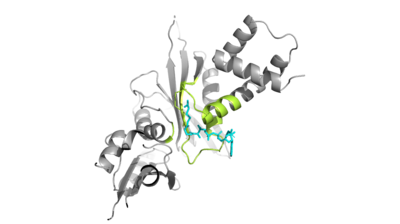User:Caitlin Marie Gaich/Sandbox1
From Proteopedia
Histone Acetyltransferase HAT1/HAT2 Complex, Saccharomyces cerevisiae
DOI 10.1002/ijch.201300024</ref> or to the article describing Jmol [1] to the rescue.
IntroductionHAT1 BackgroundHat1/Hat2 Complex StructureHat1 is not catalytically active until it binds with HAT2 to form the . HAT1 structure includes 317 residues and is identified as . HAT2 is identified as , which includes 401 residues. The activated complex acetylates residues in the 38 residue span of . The HAT1 and HAT2 interface is stabilized by hydrogen bonds, , and hydrophobic interactions. Most of these interactions are located in of the HAT1 domain, which forms a well-ordered helix. This LP1 helix is thought to be important for the heterodimer formation as the deletion of LP1 abolished the interaction between HAT1 and HAT2. This suggests that there may be another protein involved such as the N terminus tail of H4 acting as a linker protein interacting with the complex interface. The three major areas where hydrogen bonds are present aids in this complex formation. The side chain atoms of with the main chain nitrogen of Ala202 in HAT1. The side chain of makes hydrogen bonds with Leu288 and Phe205 respectively. The last area of hydrogen bonds between HAT1 and HAT is found between . The at the interface of the complex appears to be critical for the complex formation. This core consists of aromatic amino acids from HAT1 and leucine amino acids from HAT2, however it does not form any obvious ring stacking. Once the complex has formed, histone 4 and AcetylCoA can begin to interact. The N-terminal segment of H4 that binds with HAT1/HAT2 can be divided into . Similar to 1BOB the N-terminal region of H4 is embedded in a cave between HAT1 and HAT2, though H4 mainly interacts with HAT1. The C-terminal helix of H4 is found inserted into LP2, the N-terminal helix, and C-terminal groove of HAT2. These interactions are strongly stabilized by salt bridge bonds between the histone and the complex. Previous studies suggest that H4K12 inserts into the active site of HAT1 to access AcCoA. The 4PSW structure has H4K12 aligned with the active site and the AcCoA entering the concave groove from the opposite side. This allows the epsilon-amino group of H4K12 to contact the SH group of CoA. HAT targets the commonly accepted Gly-rich consensus sequence (G-3_X-2_G-1_K_X+1_G+2)of the histone substrate for acetylation.
MechanismApplicationReferencesLi, Y. et. al. Hat2p recognizes the histone H3 tail to specify the acetylation of the newly synthesized H3/H4 heterodimer by the Hat1p/Hat2p complex.(2014). Genes Dev.28:1217-1227. DOI:10.1101/gad.240531.114
Student Contributors
| ||||||||||||

